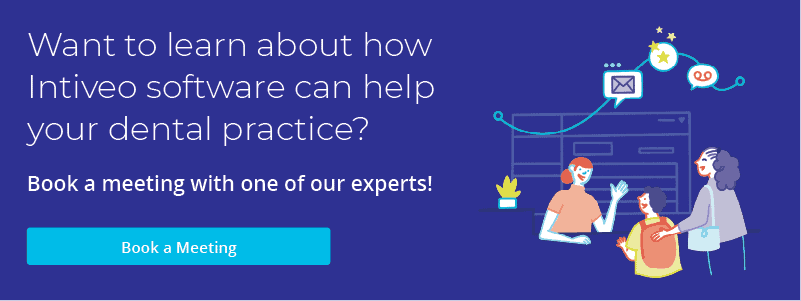What you want to focus on in serving your patients. One of the best ways to do that is to streamline your workplace with the right dental software. But where should you start? It can be hard to know where to begin! Especially if you’re choosing dental software for your practice for the first time. In this blog post, we explore different rubrics through which to choose the right software for your practice.
The Benefits of Dental Software
First off, what are all your options? There is a wide variety of dental software that can help make for a more efficient workplace. Dental management software and patient communication software are two common – and recommended! – places to start. Dental management software allows you to streamline your practice. Integrated software systems centralize your data. This saves time for staff. Patient communication software is a multi-purpose tool that allows you to stay closely connected to your patients. Dental practices report a significant decline in missed appointments, for example, when using patient communication software.
Dental imaging software is also an important consideration for your dental practice. This dental software has a number of benefits. A very tangible one is that storing x-ray images digitally reduces the number of folders in your office. This saves a great deal of space! The biggest advantage is the in-depth diagnostic tools that dental imaging software gives you.
There are a number of other types of dental software to consider, including ones that offer:
- electronic prescription writing services
- electronic statements
- electronic claim services for dental clearinghouses
- integrated credit card processing
Dental practices all over North America report that these different types of software have allowed them to streamline their workflow. With the right dental software, your practice can truly step into the modern age!
What to Expect from Your Dental Software
But what are the typical features of dental software? While there are many different products on the market, there are a few characteristics that each type of software typically shares. Here is an idea of what to expect from your new software:
- Dental Management Software: This is the software that gives your practice its pulse. This software allows you to do a wide variety of things, including charting, communicating between offices in larger practices, and keeping an electronic filing system that all your staff can use.
- Patient Communication Software: At Intiveo, this is the software we know well! This software is key to patient retention and connection. Typical features include the ability to customize how you stay in touch with your patients. You can do that by phone, text message, or email. Patient communication software allows you to set up automatic reminders for upcoming appointments. You are also able to set up customized instructions for dental procedures or aftercare. Sending the right message at the right time ensures that your patients are punctual and prepared for their appointments. In addition, patients are more likely to return for additional appointments.
- Dental Imaging Software: You know what an important diagnostic tool a dental x-ray or tomography can be. This software allows you to integrate your dental imaging tools so that they’re always at hand. A key feature of dental imaging software is the ability to show dental x-rays with a high-quality image, as well as the ability to enlarge images to show specific details and highlight certain areas with color. Many dental practices choose an ‘open’ dental imaging software, to adapt to the innovations in this field as they occur.
- Electronic Prescriptions: This particular software allows you to save your patient a lot of time. Electronic prescriptions can typically be sent directly to a pharmacist that’s convenient for your patient. Since there is a digital record of the prescription, it is easily accessible for your staff. It also allows you to monitor sensitive prescriptions.
- Electronic Statements: Make payments and claims easy! Electronic statements keep an accessible record of what your patients owe. They also make it easy to forward it to a dental insurance company, keeping everyone on the same page. Another key feature of this software is electronic reconciliation at the end of the day. This saves a great deal of time for your staff.
- Processing Dental Claims for the Clearinghouse: It’s great to be able to offer electronic claims services to your patients. Like electronic statements, it keeps your practice, your patient, and the insurance company on the same page. Processing dental claims electronically, using dental software, allows you to attach pertinent information to the claim such as an x-ray or report.
- Integrated Credit Card Processing: Software that allows you to integrate credit card information typically has strong security features. This keeps your patients’ information safe. This software makes for a faster at-the-counter payment experience for your patient.
Many different dental software brands can be found on the market. These are just some of the key features that make up this software. You’ll have fun exploring all these features – so no time like the present to get started!
Evaluating Your Practice’s Needs
Now that you know what to expect from different types of dental software, you’re equipped to start making some choices for your dental practice. But first, it’s important to consider what the specific needs of your practice are. There are some essential considerations to keep in mind when choosing the right dental software for your practice:
- The size and scope of your practice. A larger practice that requires interoffice communication will have different needs than a small, single-office practice. Specialty offices, like the OMS office, might require more comprehensive and tailored messaging, whereas a general dentistry office will have less specific needs.
- Onsite servers vs. cloud-based systems. There is an increasing trend toward cloud-based systems in dentistry practices.
- HIPAA compliance and overall industry standard compliance. Ensure that your chosen software adheres to industry standards so that your patients’ information is kept safe.
- User-friendliness. It’s important to choose a software system that your staff can learn quickly and use easily.
- Price range. The right price range will depend on your capacity and budget, as well as the model of payment you want to use. Check out more on price considerations below.
Consult a buyer’s guide with these things in mind, to evaluate what software will be right for your practice.
A Word About Trends

As we’ve noted, there is an increasing trend toward cloud-based software systems. This is the case in many different industries. The biggest advantage, as you may know from using cloud-based software in your personal life, is that relevant data is accessible from several different types of devices.
A second trend improves the experience of both staff and patients alike: the dental care mobile app. This is a versatile tool. Accessibility is a key factor here. Patients can communicate more easily with the dental practice itself.
When the Price is Right
Of course, an important consideration in purchasing anything for your business is the price. One factor at play here relates to whether or not you choose an onsite server or a cloud-based software system. Since an onsite server will need to be installed at your dental practice itself, it typically has a higher up-front cost. However, the monthly and annual costs are typically low from there on. With a cloud-based system, because the system is based online, no onsite installation is necessary.
Generally speaking, there are two types of pricing models with dental software:
- perpetual license
- subscription license
A perpetual license is what you can expect with an onsite server, although there are exceptions. There is a one-time fee to use the software in perpetuity. The annual or monthly fees associated with this are generally maintenance/support, or upgrades. These costs can vary between 15-20% of the original upfront cost.
A subscription license is generally associated with cloud-based software systems. In this case, you as the user will not be the owner of the software. The ‘cloud’ is on the Internet or another network. This is owned and operated by the service provider. Usually, you will pay per user or month. As we have noted, cloud-based software is on an upwards trend. Cloud-based systems tend to have a 99% guarantee on server uptime, and all of the management and maintenance of servers and data security falls to the service provider.
Whether you choose a perpetual license or subscription license, dental software can serve to make your workplace more efficient.
Your Office with Dental Software

Across the broad spectrum of dental software options, one salient feature is obvious: your dentistry practice can only stand to benefit! Patient retention, a less cluttered office, and accessibility of files are merely some of the features that dental software offers.
Time to get started on choosing the right software for your practice!






